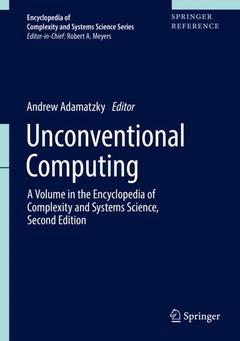Description
Unconventional Computing, 1st ed. 2018
A Volume in the Encyclopedia of Complexity and Systems Science, Second Edition
Encyclopedia of Complexity and Systems Science Series
Coordinator: Adamatzky Andrew
Language: English
Subjects for Unconventional Computing:
Support: Print on demand
Description
/li>Contents
/li>Biography
/li>Comment
/li>
This volume of the Encyclopedia of Complexity and Systems Science, Second Edition, is a unique collection of concise overviews of state-of-art, theoretical and experimental findings, prepared by the world leaders in unconventional computing. Topics covered include bacterial computing, artificial chemistry, amorphous computing, computing with Solitons, evolution in materio, immune computing, mechanical computing, molecular automata, membrane computing, bio-inspired metaheuristics, reversible computing, sound and music computing, enzyme-based computing, structural machines, reservoir computing, infinity computing, biomolecular data structures, slime mold computing, nanocomputers, analog computers, DNA computing, novel hardware, thermodynamics of computation, and quantum and optical computing. Topics added to the second edition include: social algorithms, unconventional computational problems, enzyme-based computing, inductive Turing machines, reservoir computing, Grossone Infinity computing, slime mould computing, biomolecular data structures, parallelization of bio-inspired unconventional computing, and photonic computing.
Unconventional computing is a cross-breed of computer science, physics, mathematics, chemistry, electronic engineering, biology, materials science and nanotechnology. The aims are to uncover and exploit principles and mechanisms of information processing in, and functional properties of, physical, chemical and living systems, with the goal to develop efficient algorithms, design optimal architectures and manufacture working prototypes of future and emergent computing devices.
Amorphous Computing.- Algorithmic Cognition.- Analog Computation.- Applications of P Systems.- Approximations to algorithmic probability.- Artificial Chemistry.- Bacterial Computing.- Biomolecular Data Structures.- Cellular Computing.- Computing with Solitons.- DNA Computing.- Evolution in Materio.- Grossone Infinity Computing.- Immune computing.- Inductive Turing Machines.- Mechanical Computing: The Computational Complexity of Physical Devices.- Membrane Computing, Power and Complexity.- Molecular Automata.- Nanocomputers.- Neuromorphic Computing based on Organic Memristive Systems.- Neuromorphic Photonics, Principles of.- Novel Hardware for Unconventional Computing.- Optical Computing.- Quantum Computing.- Reaction-Diffusion Computing.- Reversible Computing.- Slime Mould Computing.- Thermodynamics of Computation.- Unconventional Computing, Introduction to.- Metaheuristics.- Cuckoo Search.- Firefly Algorithm.- Sound and Music Computing.- Unconventional Computational Problems.- Enzyme-based computing.- Inductive Turing machines and complexity, super-recursive algorithms.- Reservoir computing, principles, and applications.- Collision-based computing.- Grossone Infinity Computing.- Unconventional Computational Problems.
Gathers unique contributions prepared by world leading experts in computer science, hardware, physics, chemistry, biology, nanotechnology, and engineering
Extensively illustrated with many graphical examples
Appeals to a broad audience of scientists, engineers, industry managers, and university students




